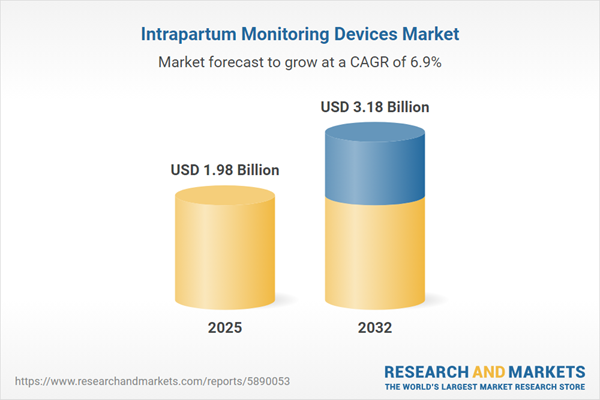Speak directly to the analyst to clarify any post sales queries you may have.
Senior healthcare leaders seeking to advance maternal and fetal care face challenges in driving clinical excellence, elevating patient safety, and ensuring cost efficiency. The intrapartum monitoring devices market delivers targeted solutions that support executive priorities while aligning technology adoption with operational and compliance goals.
Market Snapshot: Intrapartum Monitoring Devices Market
The intrapartum monitoring devices market reached a value of USD 1.85 billion in 2024, with projections pointing to USD 1.98 billion in 2025 and USD 3.18 billion by 2032. This reflects a compound annual growth rate (CAGR) of 6.94%. Market growth is driven by the uptake of real-time monitoring technologies and evolving care delivery models in perinatal environments. Healthcare organizations are focusing on devices that integrate seamlessly with existing workflows, support improved clinical documentation, and enhance interoperability across systems. Senior management and procurement leaders are increasingly guiding purchasing strategies toward solutions that deliver reliability, ongoing regulatory compliance, and scalability. Key manufacturers are responding by optimizing device capabilities and reinforcing adaptability to new guidelines.
Scope & Segmentation of the Intrapartum Monitoring Devices Market
- Technology: Non-invasive cardiotocography systems and Doppler ultrasonography offer continuous monitoring, while internal methods—like fetal scalp electrodes and intrauterine pressure catheters—provide detailed insights for complex or high-acuity cases.
- Application: Devices support use across hospitals, maternity clinics, ambulatory surgical settings, and home care environments, empowering protocol standardization and remote patient assessment.
- End User: Adoption spans private and public hospitals as well as home healthcare providers, each needing uninterrupted monitoring, efficient data exchange, and coordinated care transitions between care settings.
- Device Type: Offerings include contraction monitors (such as tocodynamometers and intrauterine catheters) and fetal monitoring solutions (for example, Doppler devices, cardiotocography systems, and fetal ECGs), providing comprehensive data for labor and delivery teams.
- Distribution Channel: Procurement is conducted through centralized purchasing hubs, specialist distributors, digital marketplaces, and retail channels, supporting consistent device access across varied provider networks.
- Geography: North America and Europe benefit from developed perinatal care systems and advanced technology infrastructure, while Asia-Pacific, the Middle East, and Africa are experiencing increased adoption, improved care standards, and emerging expansion opportunities.
- Key Companies: Major participants—such as General Electric Company, Koninklijke Philips N.V., Baxter International Inc., Drägerwerk AG & Co. KGaA, Medtronic plc, NIHON KOHDEN CORPORATION, Natus Medical Incorporated, Shenzhen Mindray Bio-Medical Electronics Co., Ltd., Edan Instruments, Inc., and Huntleigh Healthcare Limited—lead advancements in technology and streamline supply chains.
Key Takeaways for Senior Decision-Makers
- Implementing modern intrapartum monitoring platforms enhances rapid assessment of maternal and fetal status, reinforcing alignment with established protocols and supporting safer delivery outcomes across care settings.
- Integrating monitoring devices with electronic health records optimizes workflow efficiency, minimizes documentation errors, and promotes stronger care team collaboration, meeting current regulatory expectations.
- Wireless and portable monitoring technology expands patient mobility and enables providers to manage spatial constraints and dynamic staffing in high-volume clinical units.
- Supporting a modular device approach allows organizations to incrementally upgrade equipment, maintain continuity of operations, and adapt to emerging clinical requirements with minimal disruption.
- Strategic collaborations with manufacturers empower healthcare institutions to tailor device selection, adjust protocols to organizational needs, and remain responsive to updated compliance standards.
- Diversified procurement models and resilient supply logistics help maintain device reliability and operational consistency as external regulations and market conditions shift.
Tariff Impact on Supply Chains and Cost Structure
Recent adjustments in U.S. tariff policy have prompted manufacturers to rethink sourcing and distribution strategies. For healthcare organizations, timely adaptation is critical to contain costs, secure device availability, and comply with global regulations—ensuring continuity in perinatal care within a changing regulatory environment.
Methodology & Data Sources
This report leverages structured interviews with clinical, procurement, and executive stakeholders, supplemented by extensive secondary research and reviews of up-to-date regulatory information. This methodology delivers relevant, practical perspectives on current challenges and opportunities in the intrapartum monitoring devices market.
Why This Report Matters for Senior Leaders
- Obtain actionable insights to guide strategic investments and strengthen risk management within perinatal and fetal care operations.
- Gain clarity on the impact of ongoing supply chain and regulatory changes for both immediate procurement efforts and longer-term technology planning in diverse healthcare markets.
- Apply practical recommendations to reinforce supply stability and build effective partnerships, optimizing maternal and fetal monitoring across the care continuum.
Conclusion
Senior decision-makers are equipped to enhance procurement strategies, maintain high clinical standards, and respond effectively as the intrapartum monitoring devices market evolves. Leveraging these insights supports resilience and excellence across dynamic care environments.
Additional Product Information:
- Purchase of this report includes 1 year online access with quarterly updates.
- This report can be updated on request. Please contact our Customer Experience team using the Ask a Question widget on our website.
Table of Contents
3. Executive Summary
4. Market Overview
7. Cumulative Impact of Artificial Intelligence 2025
Companies Mentioned
The companies profiled in this Intrapartum Monitoring Devices market report include:- General Electric Company
- Koninklijke Philips N.V.
- Baxter International Inc.
- Drägerwerk AG & Co. KGaA
- Shenzhen Mindray Bio-Medical Electronics Co., Ltd.
- Medtronic plc
- NIHON KOHDEN CORPORATION
- Natus Medical Incorporated
- Edan Instruments, Inc.
- Huntleigh Healthcare Limited
Table Information
| Report Attribute | Details |
|---|---|
| No. of Pages | 184 |
| Published | October 2025 |
| Forecast Period | 2025 - 2032 |
| Estimated Market Value ( USD | $ 1.98 Billion |
| Forecasted Market Value ( USD | $ 3.18 Billion |
| Compound Annual Growth Rate | 6.9% |
| Regions Covered | Global |
| No. of Companies Mentioned | 11 |









